During our Russia river cruise with Viking Cruises we got beat by birch branches and jumped naked into a lake (one of us did), visited a 14th-century monastery, marveled at jeweled crowns of czars, tasted Russian moonshine and played the tambourine with the Moscow Orchestra (again, one of us).
We learned about the Russian educational system, and why every citizen got a voucher for $10,000. Here are a story and video on what it’s like on a Russian river cruise and why you want it to be your next vacation, along with tips on visiting the largest country in the world.
Why go on a Russia river cruise?
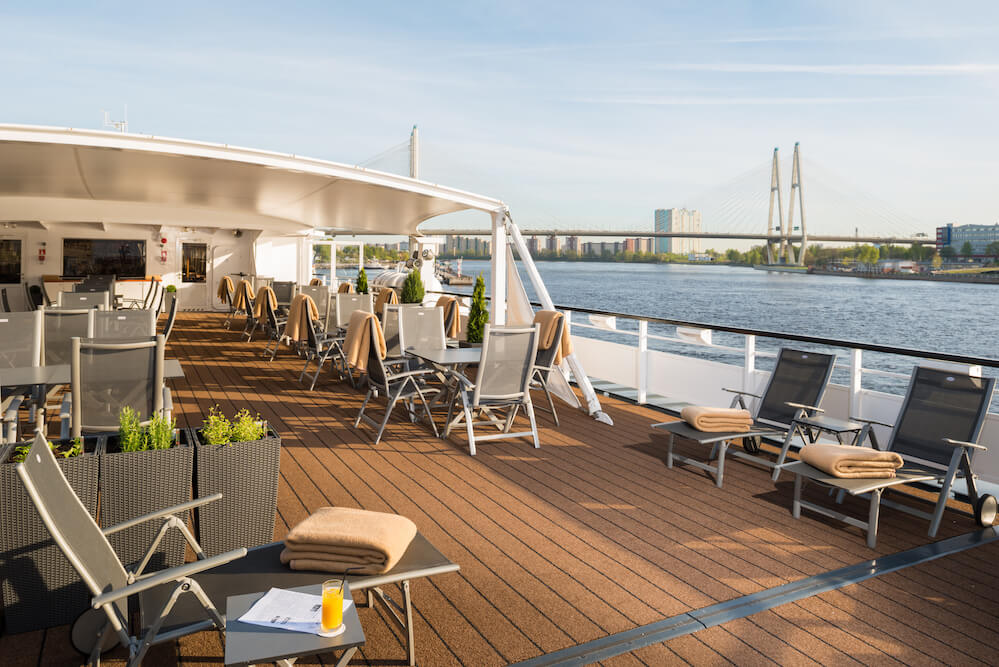
We lounged and had parties on the sun deck, weather permitting. The blankets were a nice touch when it got chilly.
My husband, Chris Schroder, declared our Russian river cruise one of the best trips we’ve ever been on. “Of all the places I’ve been, Russia was the most amazing in terms of completely reframing my perspective,” he said. “Before, I had a black-and-white, Cold War, wintry filter on all things Russian. Instead I found a forested countryside with beautiful historic churches and a nation innovating with capitalism during our Russia river cruise.”
[See related story: Tips for Taking a Russia Cruise [From Visas to Rubels]Being able to focus on one culture and learn about it more in-depth, especially one shrouded in such mystery, was the #1 reason for us to go to Russia. Our country and Russia have lived for decades in a state of mutual distrust, coming scarily close to nuclear war at one point.
I’m not sure we’ve even achieved frenemy status, but that seems of little consequence to the tourists who are flocking there from the U.S.
The total number of tourists has been increasing steadily since 2014 and last year Russia saw a 10% increase from all countries, up to 4.2 million. Groups from China make up a large portion of that as Russia now lets Chinese citizens travel without a visa.
Americans make up a small percentage of that international travel, with 227,000 visiting Russia in 2018, a 1.5% increase over 2017. It could be the time and expense involved to get a visa (see more on visas in the Tips section), the distance, maybe a level of distrust, or just the fear of the unknown.
In addition to opportunities for learning about the culture, there are several more reasons to take a Russia river cruise: it’s a beautiful country, the architecture, museums and palaces are extraordinary and you’ll have a much better understanding of what life is like there.
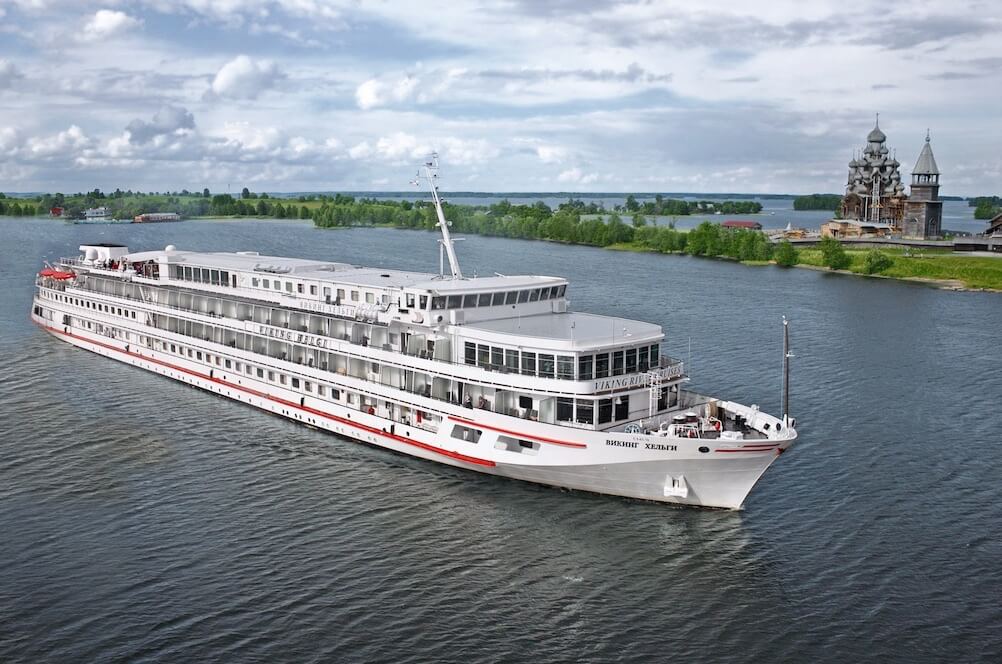
The Viking Hegli is identical to our ship, Viking Akun.
I recommend a luxury river cruise, especially for your first visit, because logistics are taken care of for you. We talked to other passengers, and several first-time visitors said they would feel comfortable coming back on their own but weren’t sure what to expect the first time. (Please note: this is not a trip you can do last minute as you do need to get a visa. You can visit Russia on a cruise ship without a visa, but not on a river boat.)
[Not sure if river cruises or ocean cruises are best for you? See related story: River or Ocean Cruise [Which is Right For You?]One gentleman told us he took the river cruise because he’s gay and wasn’t sure what it would be like for him in a country where although it’s not a crime to be gay, there is a strong anti-gay sentiment.
My daughter told me she worried about me on this trip more than any other. But I felt safe the entire time, even when we were wandering on our own in Moscow and St. Petersburg. We traveled to destinations with heavy populations of tourism, and encountered no instances of anti-American sentiment, however, the case in rural areas could be entirely different and I can only share our experience.
I also find river cruising the most relaxing, efficient way to travel. We unpacked one time for our cruise, making it an easy, enjoyable way to travel. And rather than spend a lot of time moving from hotel to hotel and en route to the next destination, we could relax on board as we moved from place to place.
[See related story on river cruising: Emerald Waterways: Stress-Free Way to See the World]Another advantage to riverboat travel is the spectacular scenery. Russia has the world’s largest area of forests, and we spent hours gliding through them on the Volga River and large lakes. I was stunned how beautiful the country is and loved sailing by the dachas, or summer homes, that line the river and the lakes.
Another bonus is we were with native Russians as guides and had experiences that might be difficult to duplicate other ways if we were traveling on our own.
For example, we took shots of homemade Russian moonshine and ate sweets in the home of a family in the village of Uglich and also visited a school where one of the students led us on a tour and told us about the educational system in Russia.
Unlike water levels in Europe that can fluctuate and cause ships to have to change itineraries because the water is too high or too low, a cruise in Russia doesn’t have that issue, according to Karoline Lander, the hotel manager who has been working on river cruises since 1992.
“Sometimes we have fog and can’t move on the rivers so we have to wait until it lifts. Sometimes we have high waves on the lakes, and may have to skip stopping at an island, but that rarely happens.”
How do you learn about the culture on a Russia river cruise?
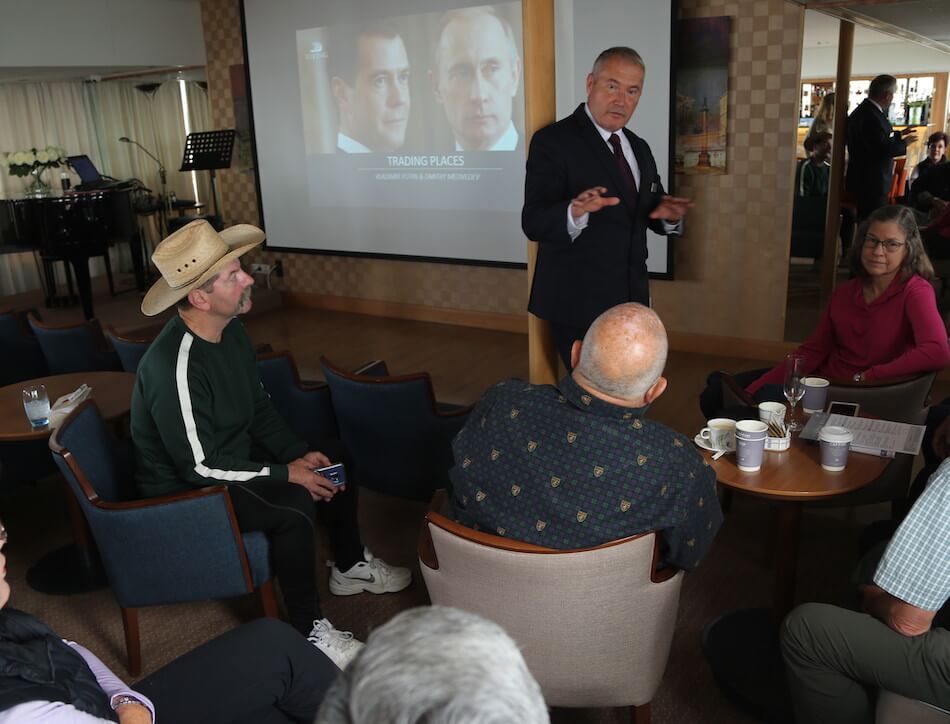
Alexey giving a lecture on why Putin is Russia’s “forever president.”
In addition to the tours and excursions we took, a big plus for us with Viking River Cruises in Russia were the opportunities to learn more about the culture while on board. Viking had several presentations during our trip, which included The Russian Language, Russian Food Culture, The Romanovs, Russia’s 20th Century, Mikhail Gorbachev, Trading Places – Putin & Medvedev. One tour escort called Putin “our forever president” and after this lecture I understood why.
There was a really helpful presentation on shopping in Russia and what to buy where. We learned that some of the most popular souvenirs include shawls, lacquer boxes, amber, and of course, Russian nesting dolls, which first appeared in Moscow in the 1890s.
During the 20th Century presentation we learned about how the economy had to adjust practically overnight when the Soviet Union disbanded in 1991. Think about that – the basis of the entire economy changed from everything being state owned to being put into private hands. That’s when every citizen of Russia, even one-day old babies, were sent a voucher for $10,000 to invest in one of the newly public companies. “It was madness. We had 148 million minority shareholders,” our guide Alexey said.
He and our other tour guide Sasha, the hotel manager Karolina and program director are all from Russia. They led the sessions and could answer any questions we had then or later in the trip.
We had a Russian cooking demonstration where we learned to make pelmeni, an impossibly delicious meat-filled dumpling eaten as is or with melted butter or sour cream. I devoured my bowl of these lovely baby dumplings and piled my plate high when I saw them again on the lunch buffet.
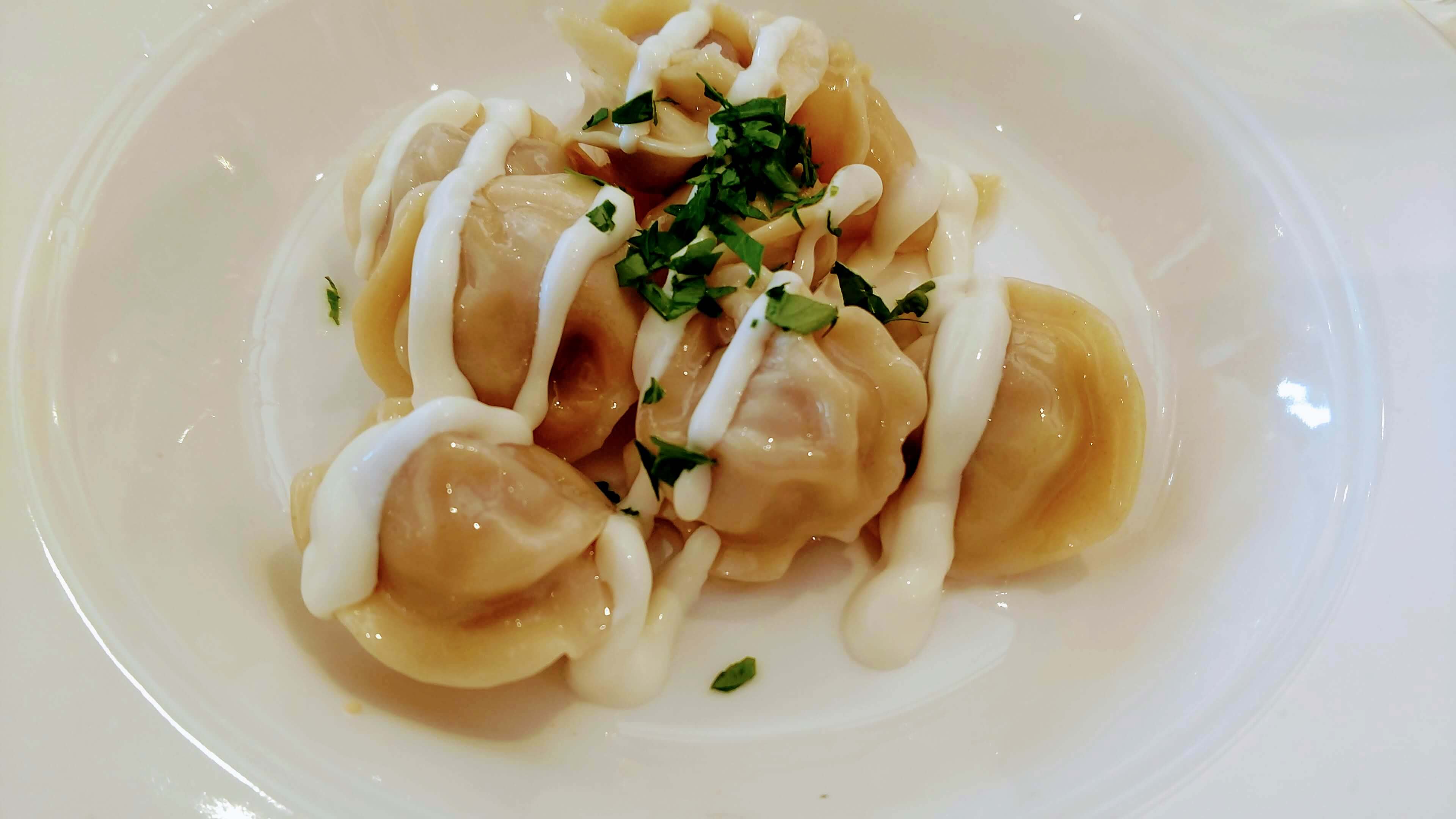
Pelmeni in Russia date back to 12th-century Siberia. They were easy to freeze so hunters took them on expeditions. Which is the only good reason I see to be a hunter in Siberia. Or anything in Siberia.
As for the Russian language, I missed the first lesson and don’t really have a facility for languages but did learn the Russian equivalent of “Cheers.” They taught us to say “na zdarovje.” There was a large group on our ship who interpreted it as “nice driveway.”
There was an additional charge for the vodka tasting, a liquor we don’t usually drink, but hey, when in Russia, right? Led by Maître d’ Marina Zabavina, the session included six shots of vodka, which in Russia translates to seven. She taught us that in Russia, “there isn’t much distance between the first shot of vodka and the second.”
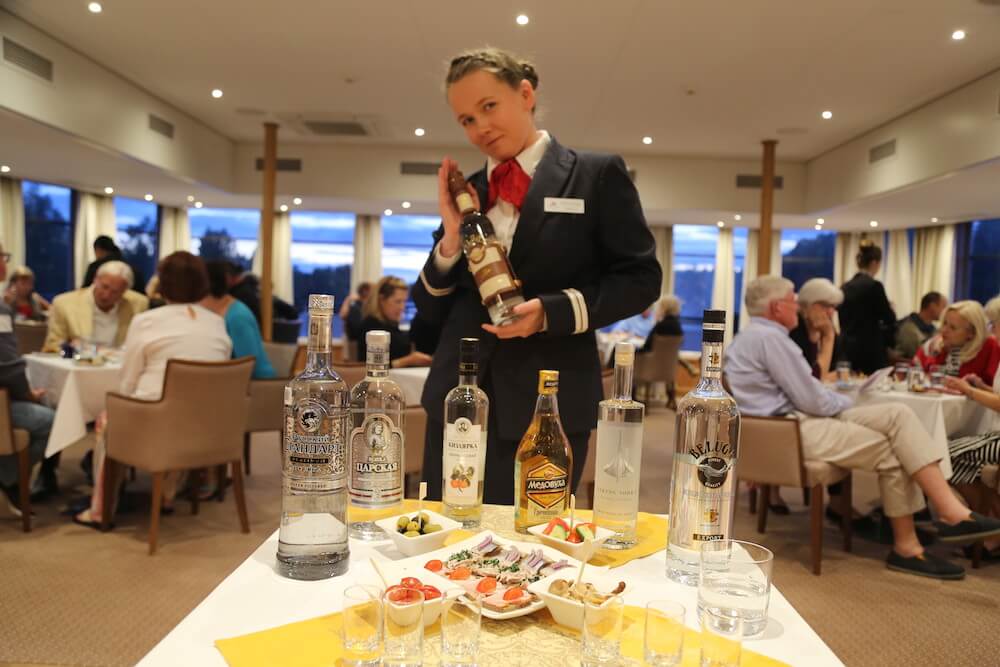
I don’t usually do shots, but surprised myself by downing all seven during a vodka tasting with Marina.
Also helpful were the notes we got on each destination in the Viking Daily, a newsletter left on our bed each night. We made stops in places I’d never heard of, like Uglich, Kizhi Island and Mandrogy. The notes gave us a bit of history and highlights of each destination.
With presentations on cooking, culture, language, food and history, our river cruise was an immersion in the Russian culture, which really elevated the trip for me. All tours, excursions and presentations are led in English.
Fun Facts About Russia
• It’s 6.6 million square miles, twice the size of the United States.
• The population is around 142 million, with most of the population concentrated west of the Ural Mountains. We have 327 million people in the U.S.
• It spans 11 time zones.
• It borders 14 countries. Compare that to our two in the U.S.
• The currency is the Russian ruble. As I write this, there are around 64 rubles to the US dollar.
• Many Russians study English in school although it’s not widely spoken outside large cities.
• Signs in the airports in Moscow and Russia are in English.
• Russians wear wedding rings on their right hands. For the first several days I just thought everybody was single.
Where does a Russia river cruise go?
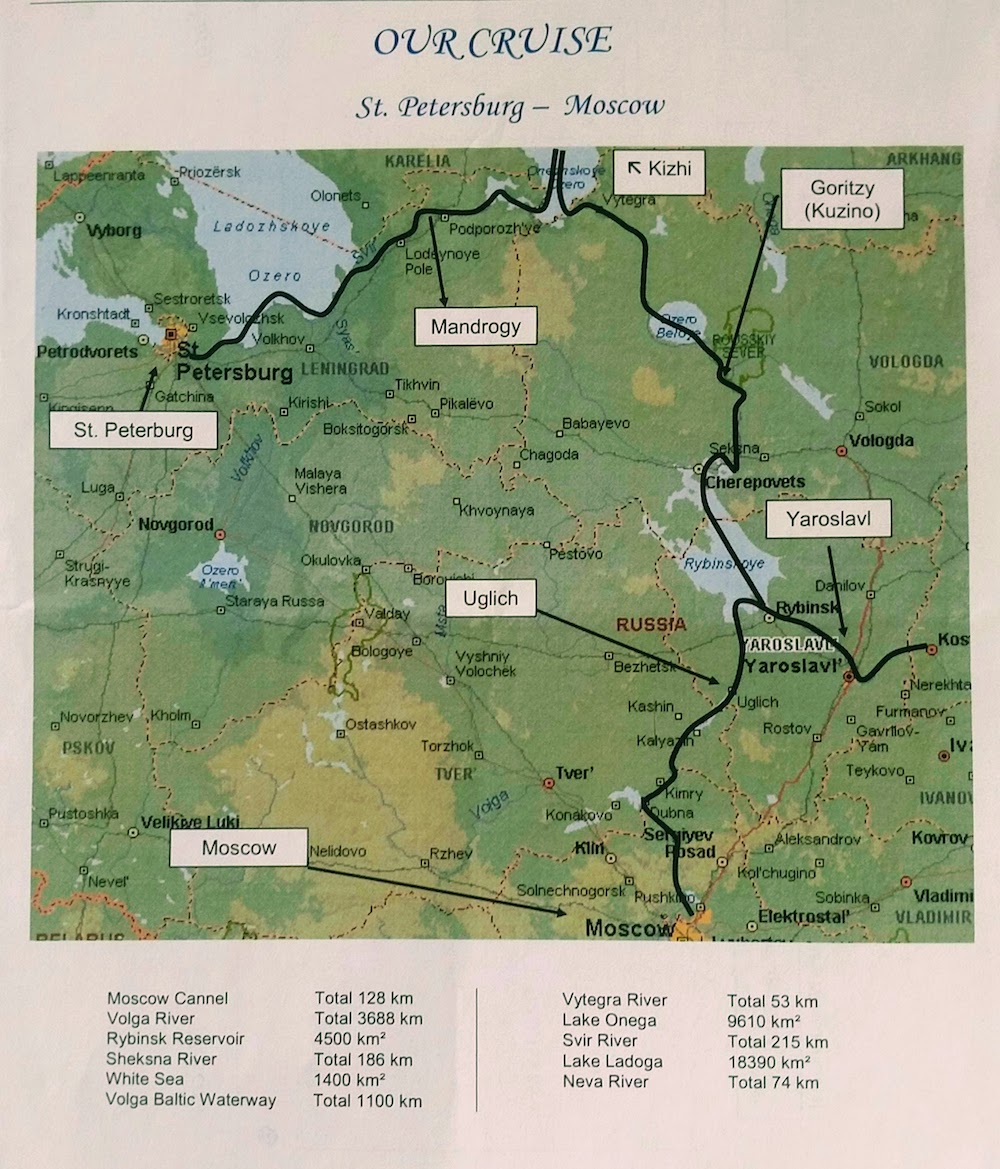
Most river boats in Russia follow the Volga River between St. Petersburg and Moscow, as seen on this map of our Russia river cruise.
Most river cruises in Russia travel between Moscow and St. Petersburg on the Volga River and the larger lakes along its path. The Volga River is the longest river in Europe, at close to 2,300 miles, and about 50 million people live in the Volga basin.
Most of the river freezes during the winter, so the season for river cruising in Russia typically lasts from early May to the end of October. While we did encounter lots of crowds at the palaces and sites in Moscow and St. Petersburg, the ports were not crowded. We were often the only ship docked at a port.
We started our journey on the Viking Akun with three days in Moscow and ended with three days in St. Petersburg, a typical itinerary for river boats. With some cruise lines you will stay in a hotel during those three days in each city, but with Viking you stay on the ship the entire time. Other lines that offer Russia river cruises include Scenic and Uniworld Boutique River Cruise Collection.
Here’s another fun fact: Viking River Cruises has operated in Russia since 1997, and unlike other cruises lines there, owns its ships rather than chartering them.
Why should you travel with Viking River Cruises in Russia?
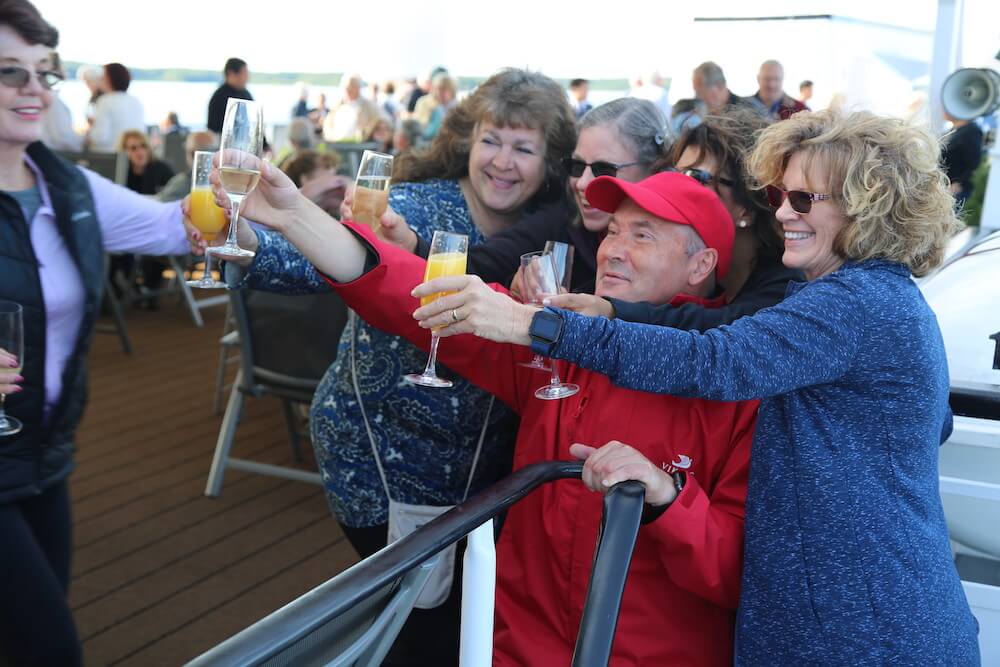
Passengers toast with Alexey during the Sail Away party.
I’d heard their British-accented ads a billion times during Masterpiece Theater so was familiar with the brand, but this was our first trip with Viking River Cruises. We were impressed by the level of service and the friendliness of the staff. Each time we took off on an excursion our Program Director Margo Goncharova and Hotel Manager Karoline Landa stood outside, smiling and waving as our buses pulled out. And they were there again when we returned.
Our tour guides Sasha and Alexey accompanied us on our tours and kept us entertained during bus rides or waits at the palaces. Sasha regularly cracked me up with his jokes and irreverent attitude to the Russian way of life.
At Peterhof Palace we were in line when a black-clad staff member came over to talk to him about our group’s position and when we could move up. As he walked away, Sasha said, “That man is wearing black so you know he’s very important. Who knows how many people he’s tortured in some KGB basement?” Then he said, “When we go inside we will encounter many Russian women of indeterminate age with gold teeth who will not be smiling. They are very strict. If you take a photo where you shouldn’t or disobey them, they will escort the group out or hit you in the head with a fan.”
We took his warning seriously, obeyed all the somber looking museum ladies, cutting them a wide berth to stay out of fan-hitting range. My husband went to Catholic school back in the nuns-with-rulers phase, so he knew the drill.
The reception area of the Viking Akun is manned 24 hours a day so if we ever had a question we could ask. The Viking Akun also has a doctor on board, who travels with the ship. Ours was a very nice man named Mikhail Shevchenko. It was comforting to know there was medical care on board as we traveled through remote areas, not knowing how far we were from a hospital.
I haven’t traveled on the other cruise lines in Russia, so can’t compare them, but I can tell you some things we really liked about Viking River Cruises.
Top of our list was the food. Breakfast and lunch were buffets, although there was also a menu for ordering a la carte. Dinner was a three-course meal with a choice of starters and main course. A regional specialities tasting menu was always available at dinner so we enjoyed items like borscht, which I didn’t think I’d like as I’m anti-beet, but I loved it. One night we had salmon coulibiac, puff pastry stuffed with salmon and spinach and covered with red caviar sauce.
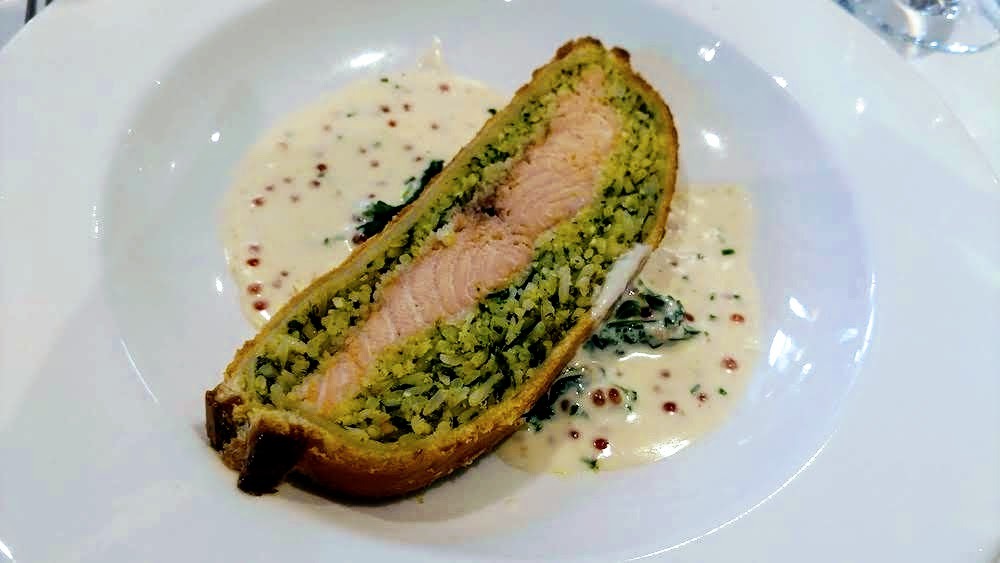
We had a lot of options for local dishes on our Russia river cruise, including this delicious salmon in puff pastry.
Our chef was from Greece, so I suppose it’s no surprise that we had to best Greek salad ever outside of Greece. Soups were all delicious as was just about everything we tried. One day we ordered hamburgers and had to push a bit to get them cooked medium rare, but they complied and we loved them.
One of the Viking River Cruise touches we appreciated was a different type of fresh fruit left for us in our cabin every day. And the unexpected celebrations were fun. One afternoon there was a Meet Your Neighbor party. Staff handed out orange juice and Champagne and people introduced themselves in the halls. Another day we had an amazing Sail Away party on the deck where Champagne and vodka were free flowing.
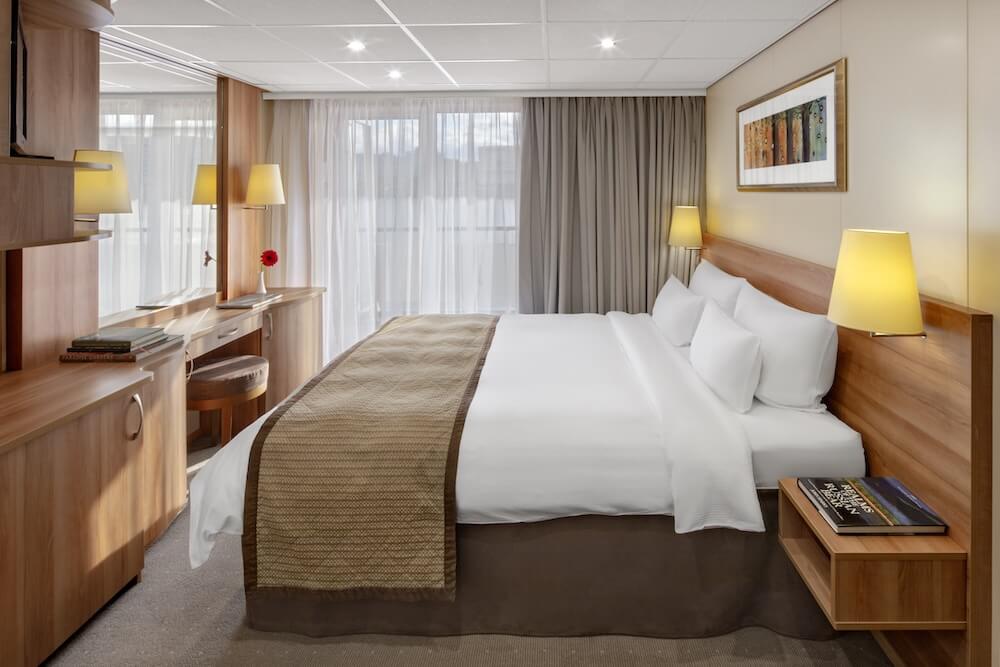
A Veranda State Room on the Viking Akun.
There was supposed to be a Russian lunch on the deck one day. Unfortunately a last-minute shower drove us indoors, but the food was still very good. It’s true you don’t have eat in a lot of local restaurants when you travel by riverboat, so I really appreciated the option every day for local cuisine.
In a country where we don’t speak the language, it was helpful to have someone from Viking helping us out every step of the way.
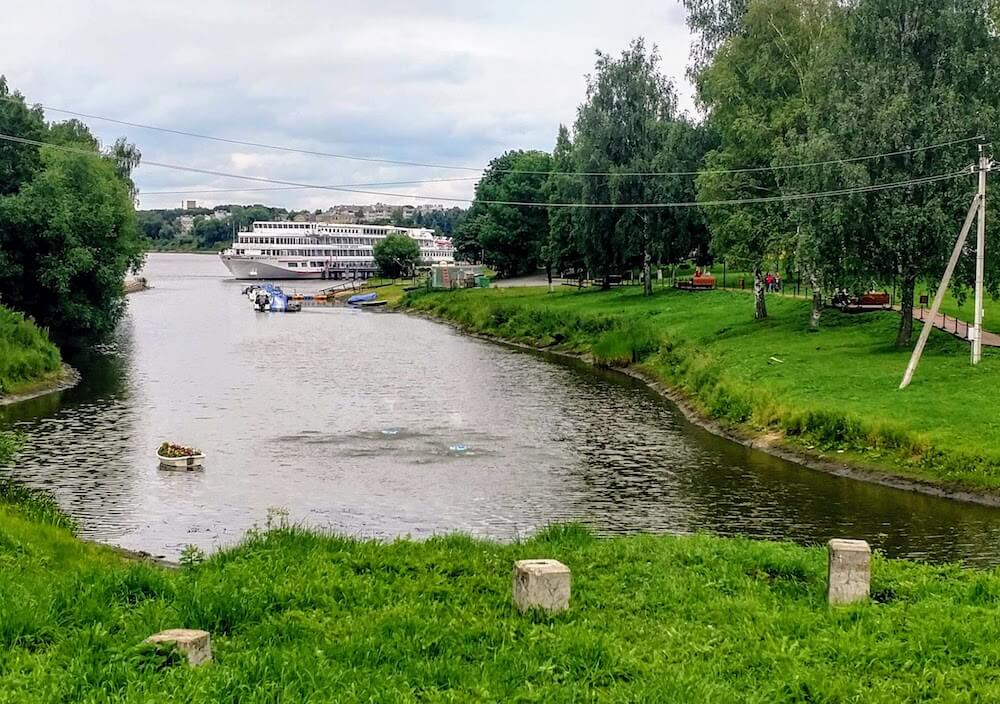
Here’s a good example of the lushness of the Russian landscape we passed through during our journey.
At the end of our trip we all packed up and waited in the lounge until our bus was called. When it was our turn, our group piled on the bus and headed to the airport, about 20 minutes away. For the first time we did not have a Viking tour guide and the bus driver did not speak to us. The bus pulled up a distance from the entrance of the airport and people were glancing at each other, unsure of what to do next.
Then we looked outside and saw Sasha in his bright red Viking shirt and the tension on the bus immediately dispersed. Just as he had done throughout our trip, Sasha was there to get us to our next stop.
“We will take your bags so we can all walk lightly and elegantly to the check-in for happy reunion with our luggage,” he said. He stayed with us until everyone was checked in and knew where to go to get to their gate.
With Viking an excursion in every port is included, with optional excursions you can pay for. Airport transfers are also included, as is beer and wine with lunch and dinner. Gratuities are not included, and $25 per person per day is added to your final bill. You may adjust that amount as you see fit.
The ship was immaculate and we heard from another passenger that one night the entire staff stayed up until the wee hours scrubbing every inch of it down, which is done once for each cruise.
Russia river cruise itinerary with highlights and tips
Prior to our cruise, we received our documents, luggage tags and a detailed itinerary with our flights and useful information like how long each flight was and what meals were served.
It had all the information we needed about the excursions, gratuities, packing and currency. along with information on purchasing a beverage package.
Moscow, Russia
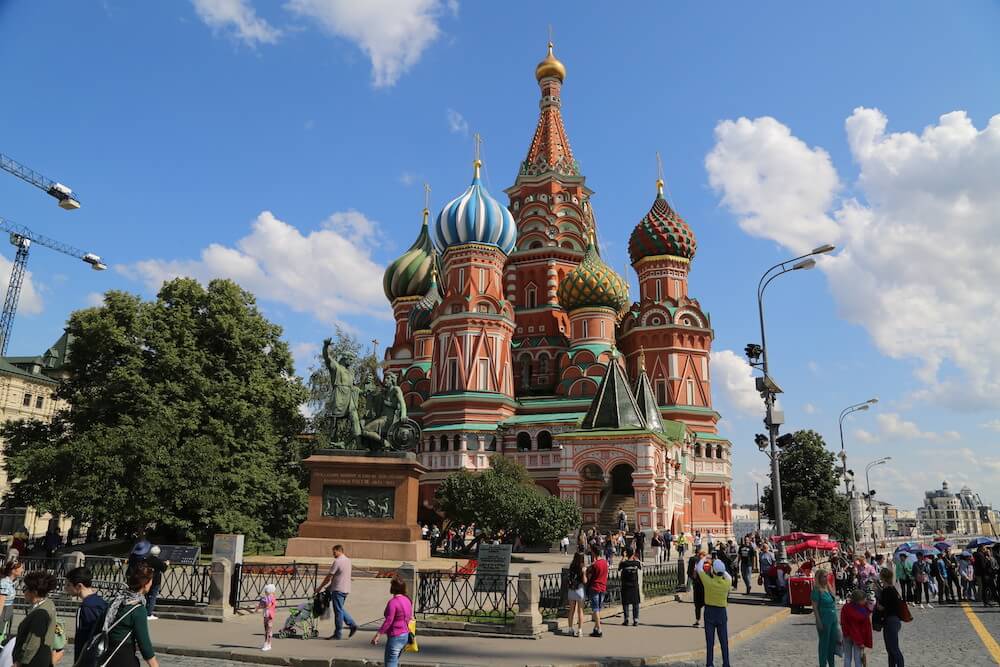
Now a museum, St. Basil’s Cathedral in Red Square is considered a symbol of the country. One legend has it that Ivan the Terrible blinded the architect after construction was complete so he’d never design something so beautiful again. Guess he was pretty terrible.
We were met at the Moscow Airport (full name: Sheremetyevo Alexander S. Pushkin International Airport) by representatives from Viking, then boarded the bus for our trip to the Viking Akun. With a population of over 12 million people, Moscow has some serious traffic, so at 45 minutes it took us slightly longer to reach the boat than usual.
But our bus was comfortable and we could enjoy the sights, which included lots of car dealerships, KFCs and an IKEA. Other than the Cyrillic alphabet, we could have been in just about any major city.
A note on the buses, which we rode several times. They were nice motor coaches with restrooms on them, although I never saw anyone use one. By law in Russia, a motor coach cannot be moving if someone is in the restroom, so the bus driver would have to pull to the side of the road.
We made it to where our ship was docked and I was delighted to see it was right by a park on the Moscow Canal, which connects the Moskva River with the Volga River. It was a beautiful setting, although like many things in Russia including the gorgeous Moscow metro stations, it was built during the Stalin era when workers weren’t treated so well. Let’s just say he didn’t place a lot of value on human life.
Millions of labor camp prisoners worked on the canal and completed it in 1937. The canal was crucial as it gave Moscow access to water sources, which include the White, Baltic, Caspian, Azov and Black Seas.
Highlights of Moscow
• Riding on The Metro. It was the fastest way to get to major attractions and the stations are stunning, filled with mosaics, stained glass, chandeliers and beautiful tile work.
• St. Basil’s Cathedral and Red Square. You’ve seen the multi-colored domes of St. Basil’s, which dates back to the 1550s. And of course, Red Square is arguably the most famous place in Russia, its huge square expanse of cobblestones filled with tourists.
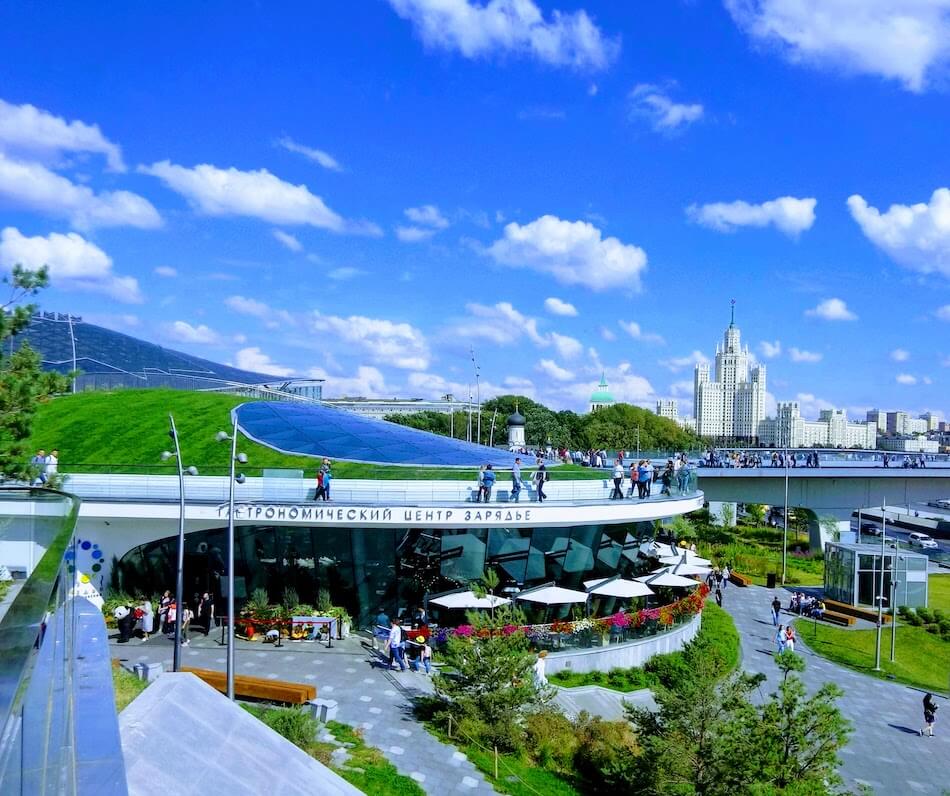
Zaryadye Park opened in 2017, the first public park in Moscow in over 50 years. The V-shaped walkway extends over the river and is a favorite spot for selfies. I could have spent hours exploring this park.
• Strolling through Zaryadye Park. This new park, opened in 2017, was not on our itinerary, but I’d read about it and we made our way there during our free time. It’s just a short walk from Red Square and the landscaping and floating bridge over the Moscow River are worth the walk. Designed by American architects, the park has magnificent views of the city.
•Treasures of the Kremlin Armory. A visit to the Kremlin was included with trip, but we opted to purchase the optional tour that included a museum tour where we saw Faberge eggs, jewel-studded crowns and thrones and imperial horse carriages. The Armory was truly a highlight of Russia. I thought the Kremlin was one building, but it’s actually a walled city that dates back to the 12th century. Our guide pointed out where Putin’s office is and where he receives important visitor.
• A tour of Sergiev Posad. An 8-hour trip to this monastery was optional and I had a hard time deciding whether to do this or spend an extra day in Moscow on our own, but I’m glad we took this tour. The monastery was founded in the 14th century and is considered the spiritual center of Russian orthodoxy. Three hundred monks make their home there. One robe-clad monk led us on a fascinating tour of several buildings in the compound.
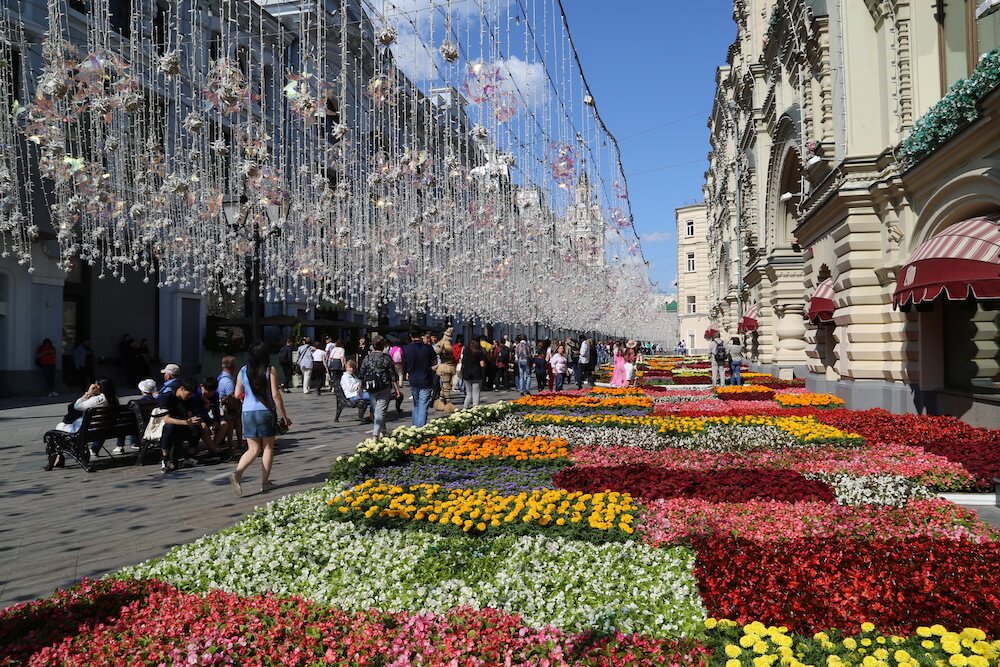
The exterior of the famous GUM department store in Moscow. It’s a high-end mall with gorgeous landscaping where people line up at kiosks to buy ice cream.
In one church, where we weren’t allowed to take photos, people wrote down prayers. Women were singing and a priest was praying for each person. So beautiful and moving. I had forgotten my scarf to cover my head, which gave me an excuse to buy a new one in the gift shop.
• Playing tambourine with the Moscow Orchestra. Yes, this happened. One evening the Viking passengers were taken to a performing arts venue to hear a classical folklore concert.
I admit I wasn’t too excited about it. I expected something pretty cheesy, a step above a Six Flags concert. However, the music was fantastic and the musicians were incredibly talented.
At one point they asked for some volunteers from the audience to come up and after a while only one woman raised her hand. Somehow I found myself raising my hand and made my way up on the stage. It’s perhaps a good time to pause in this story for a little background about my musical ability. I have none. I was kicked out of choir in third grade and sent to take recorder lessons, a move usually only reserved for the boys.
Yay to me for breaking the gender barrier at McClatchey Elementary School. I also took piano lessons, but never progressed too far, and much to Miss France’s delight I’m sure, I gave it up.
But I was in luck. As I got on stage, the leader handed me a tambourine. While I may not be able to carry a note, and the Happy Birthday song in our house is a cringe-fest, I pride myself on excellent rhythm.
“Just follow my lead and play when I signal,” he said. I followed his instructions and played the heck out of that tambourine. We even have a video my husband took if you want to know what a musically challenged person playing the tambourine on a Russian stage looks like.
Travel tip: Visit the Special Offers page on Viking’s website to find deals.
Tips for Moscow
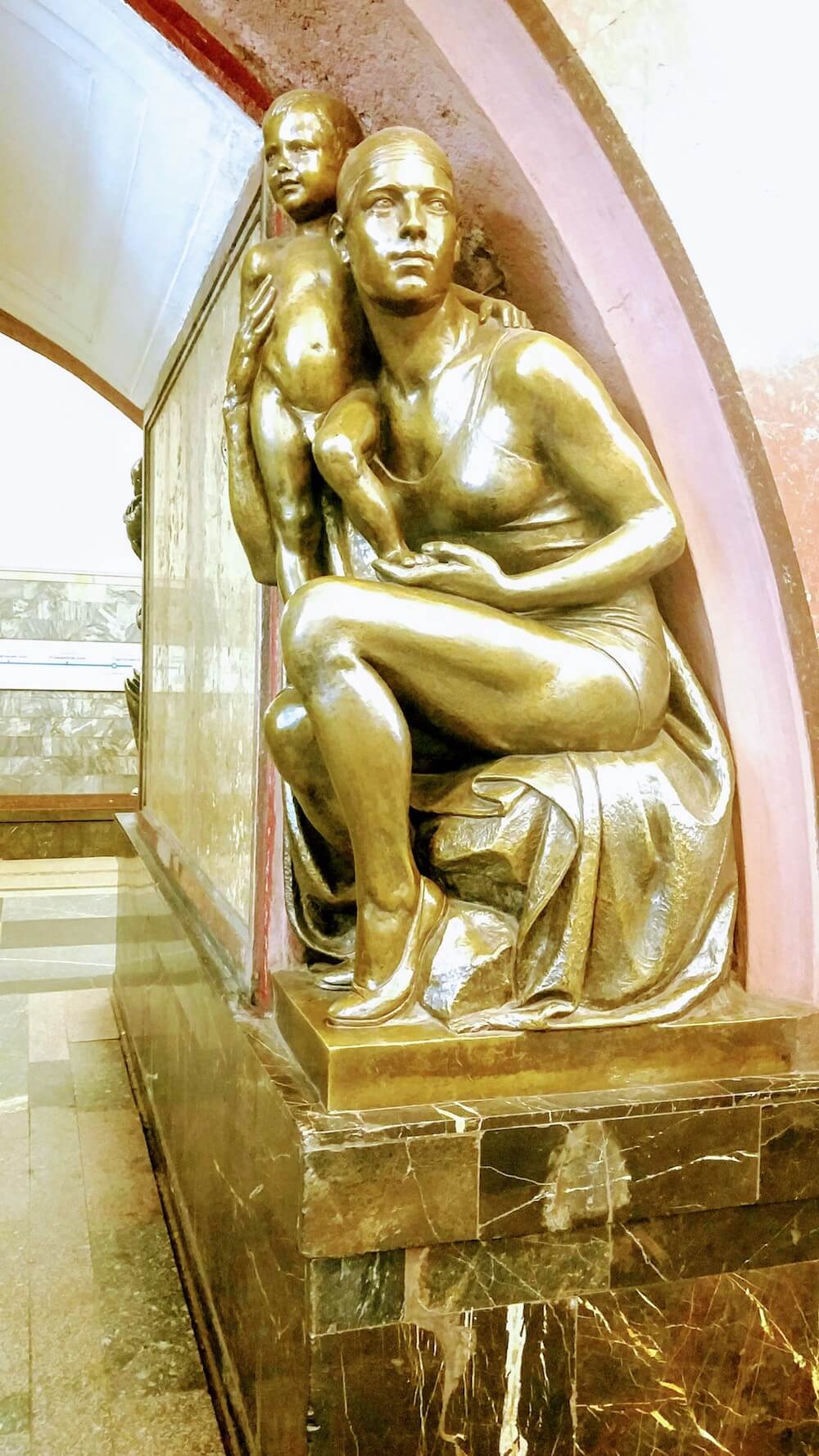
A statue in a Metro station in Moscow.
• If possible, take the Metro. Signs and announcements are in English and it’s easy to navigate. Here’s a fun fact: If you hear a man’s voice making the announcements of the upcoming stations that means you are heading towards the city center. If it’s a woman, you are heading away. On the circular line the man makes the announcement if you are going clockwise and the woman for counterclockwise.
• Crime isn’t a major concern in most areas of Moscow where tourists go, but like in any big city, you need to beware of pickpockets. I took this Travelon purse with me as it has zippered pockets that you can secure and a strap that can’t be sliced. My husband usually left his wallet at home, but if he took it, I put it in my bag, zipped it up and hooked it closed.
Uglich, Russia
Ivan the Terrible’s wife didn’t have good memories of Uglich, but I do. In the 16th century he exiled her and their son Dmitry there. This city was founded in 1148 and has a population of around 35,000. Uglich is one of Russia’s Golden Ring cities, a collection of old cities with the most significant churches and kremlins, the Russian word for citadel.
Many people in Moscow have dachas, or summer homes, here. Dachas are often small homes, some with outdoor bathrooms, and gardens.
Highlights of Uglich, Russia
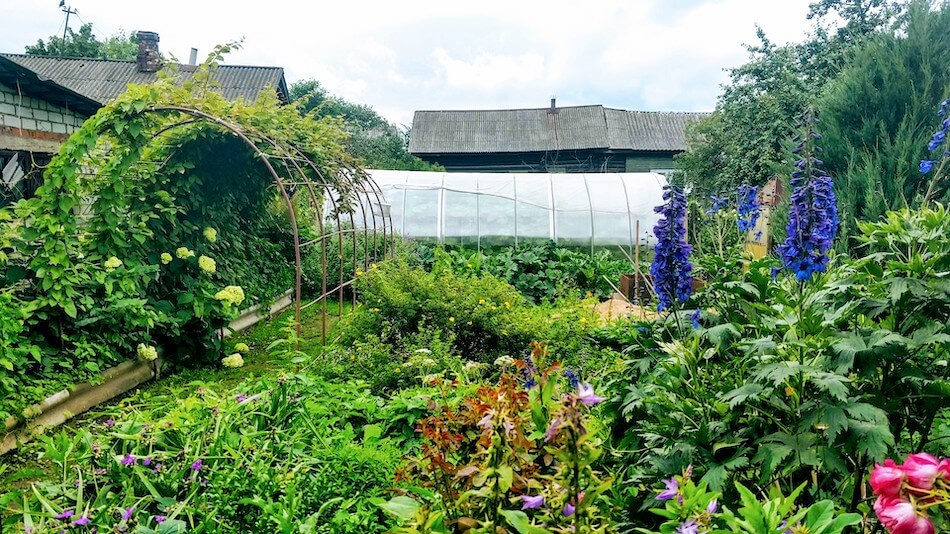
Most people in Moscow live in small apartments so they own dachas, or summer homes, where they can plant gardens like this one in Ulrich.
A home visit with local resident Irene. We went to Irene’s home where our small group sat at tables, drank her homemade vodka and enjoyed some sweets she had made. Apparently it’s common for Russian families to make their own alcohol, which they call moonshine, but they aren’t allowed to sell it or take it out of their homes. She shared her story of what life in the village is like and allowed us to tour her garden.
•Church of St. Dmitry on the Blood. This bright red church with blue-domed spires was built on the spot where Ivan’s son died.
Yarolslav, Russia
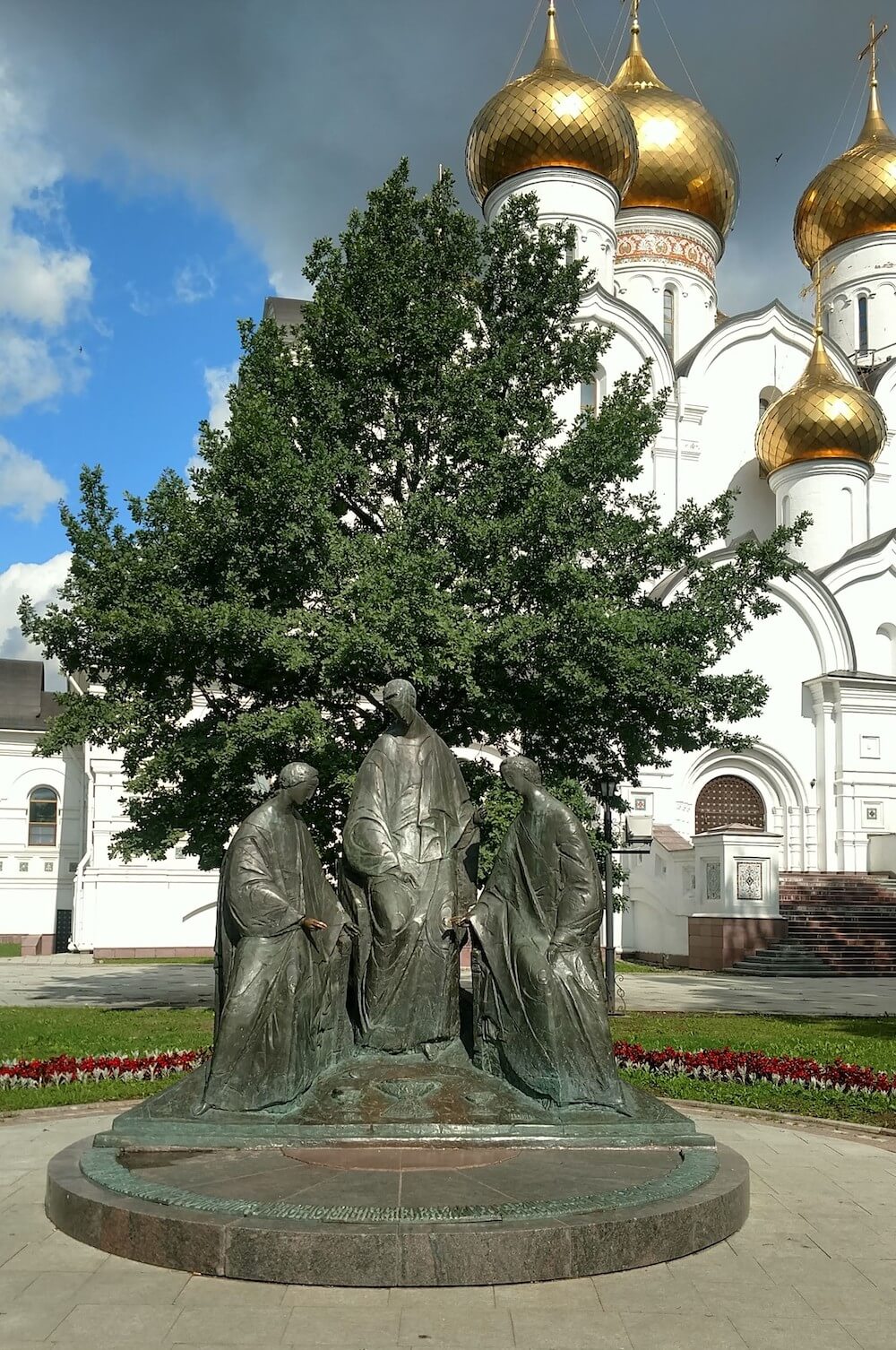
The Trinity Sculpture in Yaroslavl.
Of all the cities and villages we visited, Yaroslav felt like someplace I could live. It has a population of around 600,000, beautiful churches and spectacular gardens right on the river created when the city celebrated its 1000th birthday in 2010.
We did see some of the ugly 1960s Khrushchev-era buildings here, but there are also beautiful 19th century homes, and several movies have been filmed here for that reason. These include “Anna Karenina,” “Red Heat,” The Bourne Supremacy” and “Mission Impossible: Ghost Protocol.”
Highlights of Yaroslav
• A walking tour of the city was the highlight. We walked several miles and toured some of the magnificent churches. Our guide told us people stand up during church services in Russia, which explained the lack of pews.
• The chocolate shop. We loaded up on Russian chocolates at a shop recommended by our guides.
Kuzino, Russia
There’s really just one attraction in this small port town where we stopped to see the Kirillo-Belozeresky Monastery, built in 1397. It was shut down in 1924, like almost every church in Russia was during the Bolshevik government, which outlawed religion.
The monks were all arrested or killed. While most monasteries were converted to concentration camps for political prisoners, this one was maintained as a museum.
Kizhi Island, Russia
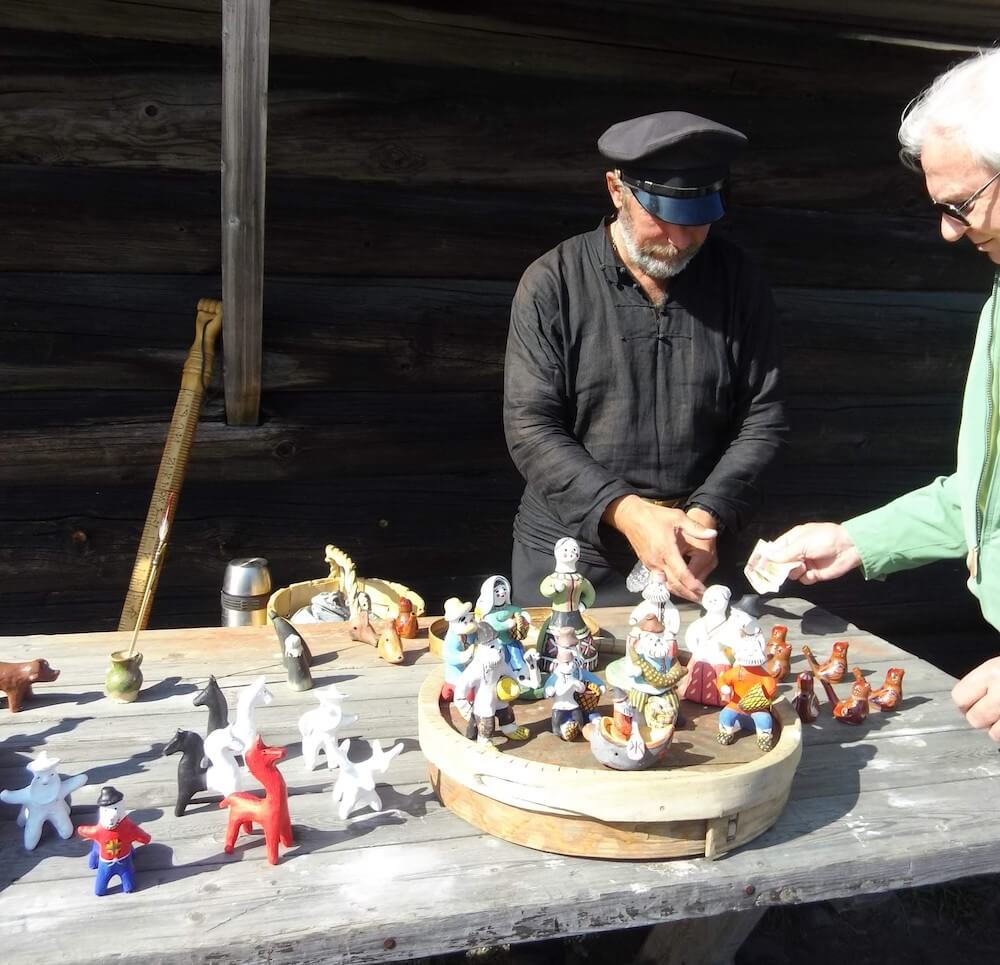
Are these small wooden figures enchanting? This vendor was on Kizhi Island.
The sun was shining, the weather was perfect and the scenery was spectacular as our ship arrived at the isolated Kizhi Island in Lake Onega, the second largest lake in Europe. The entire island is a museum, the Open Air Museum of Architecture, filled with historic homes and buildings from the 15th century moved here to preserve them. Our tour guide, Nadia, has been a tour guide for 27 years and motors her tiny boat from a neighboring island to give tours.
Highlights of Kizhi Island
• Two churches from the 18th century with domes made of wood and built without nails as they were too expensive during its construction in the 18th century. The Transfiguration Church has an amazing 22 domes, under restoration when we were there.
• A chance to learn what it was like to be a farmer in the 18th century. Several generations of a family would live together, sleeping and spending their days in one large room.
• Our Sail Away Party on the deck as we pulled out of Kizhi Island. We drank Champagne, enjoyed some Russian canapes, and may have downed a shot of two of vodka. Well, Chris downed several and became fascinated with the sea gulls who were following along the boat, which led to 387 seagull photos and videos. I will spare you, but I imagine this was a highlight of our Russia river cruise for him. I was afraid to confirm that fact.
Mandrogy, Russia
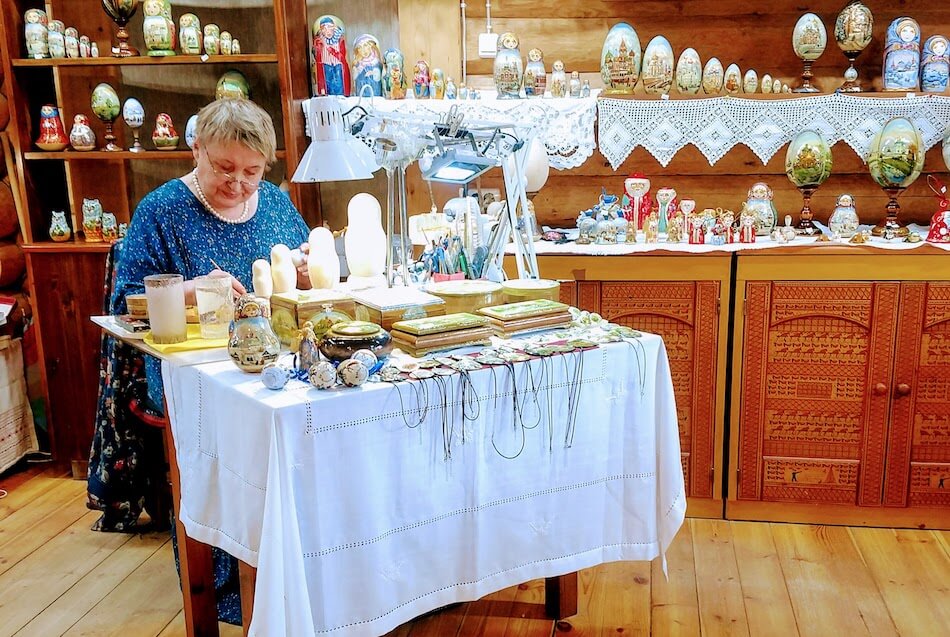
One of the artisans on Mandrogy Island. We loved the nesting dolls with building on them on the top shelf on the right, and regret not buying them. We may be the only tourists ever to leave Russia without nesting dolls.
During a tour of Russia, you’ll hear a lot about WWII. More than 27 million people in Russia died during the war, and many cities, villages and palaces were heavily bombed. The small village of Mandrogy was destroyed by the war and had pretty much disappeared off the map.
In the mid 1990s Sergei Gutzeit decided to resurrect it as an open-air museum focused on Russian traditions. Amongst the trees and dirt roads that wind around the island, visitors find windmills, homes made of pine logs, museums and structures housing artisans busy at their crafts.
Highlights of Mandrogy
• Wandering around the tree-lined dirt paths early in the morning as people were just waking up and heading to their jobs.
• Going in and out of the wooden structures that housed artisans hard at work. In one, we saw ladies imprinting silk scarves and I bought one with leaves on it. In another small one, where my tall husband had to duck way down to enter, a man was making earrings out of birch wood. One shop had several tables where women were meticulously painting the famous Russian nesting dolls.
• Getting naked, being beaten with birch leaves and jumping in a freezing cold Russian lake. Really. We signed up for the optional Russian banya, or bath, and our group of intrepid passengers walked down the dirt road to a group of wooden structures close to the lake, where we were split into groups of six.
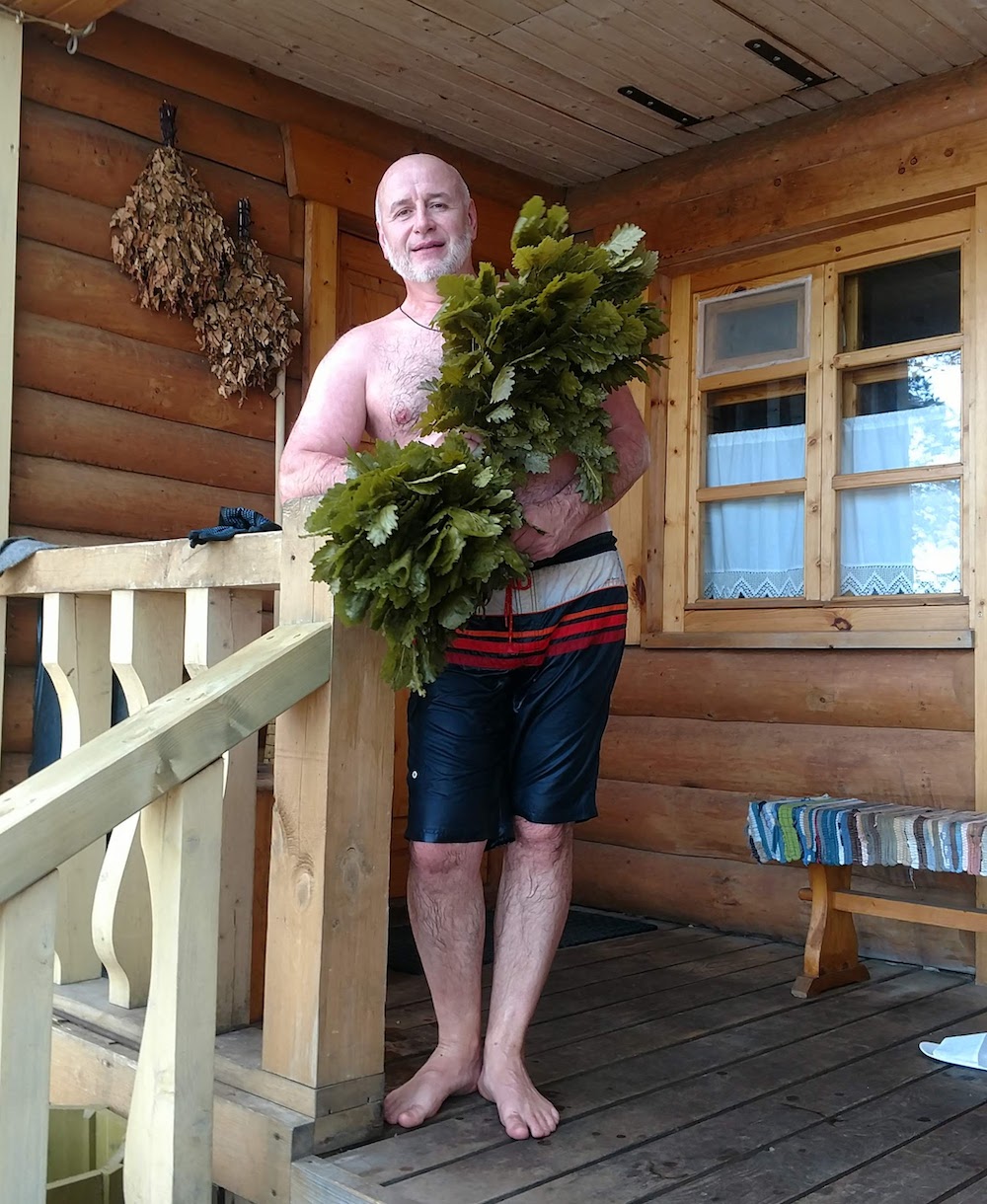
This man beat us with these birch leaves. And we paid him to do so.
My group of women from our Russia river cruise headed inside where we took our clothes off, wrapped ourselves in a towel and put on a pointed felt hat to protect our hair and keep our brains from melting. I have a photo but have decided to keep that one for the private collection.
Our guide led us all into what looked like a regular sauna and told us to sit side-by-side on the top bench. He then closed the door, grabbed two large branches of heated-up birch leaves and lightly beat us with them one by one as the steam wafted around us.
The branches are meant to open your pores and improve circulation. It felt like a warm, gentle massage, and was surprisingly pleasant.
Meanwhile the temperature rose and we were getting hotter and hotter. When he had come down the line three times, and just when I was about to burst out of there or burst into flames, he told us to get out and go jump in the lake.
Jump in? I did not have a swimsuit with me and so opted to put on my underwear and bra. Our group made our way down the short dock where we took turns plunging into the freezing water. One woman looked around, didn’t see anyone around, and jumped in naked.
Our groups were staggered so we were the only ones out on the lake at that time, although as we headed in we saw a group of naked men, including my husband, making their way down the dock next to us.
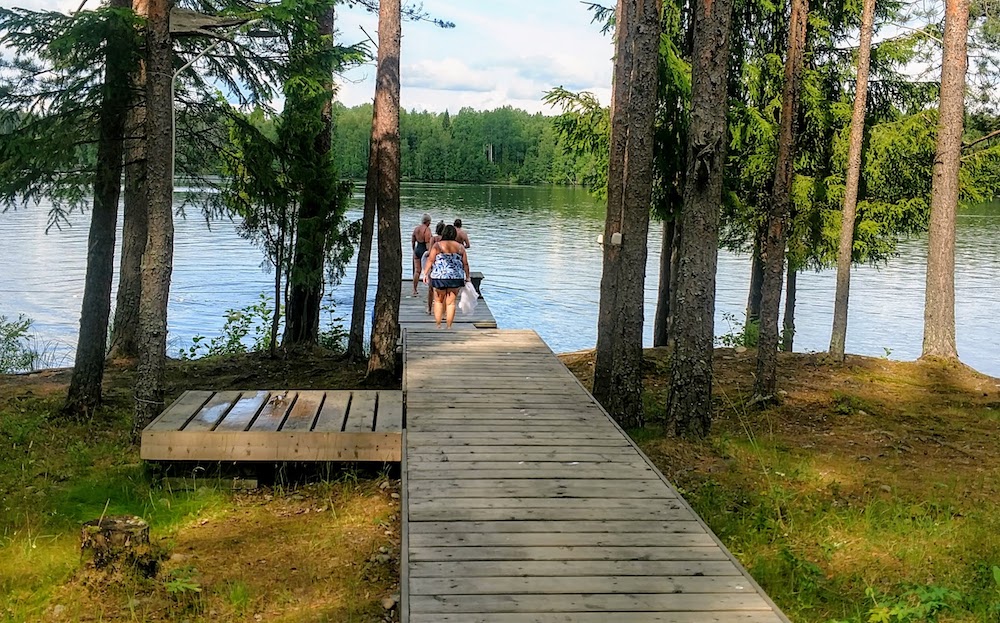
Heading to the dock to plunge into the cold water after a round in the banya.
This entire process is repeated two more times. We then got dressed and followed his instructions to have a seat and enjoy a mug of tea. We all loved it and felt relaxed afterwards with more understanding of this Russian tradition, which dates back to medieval times.
When comparing notes later, my husband said they only did two rounds in the steam room, and their guy dumped cold water right on their heads. I liked our method better.
St. Petersburg, Russia
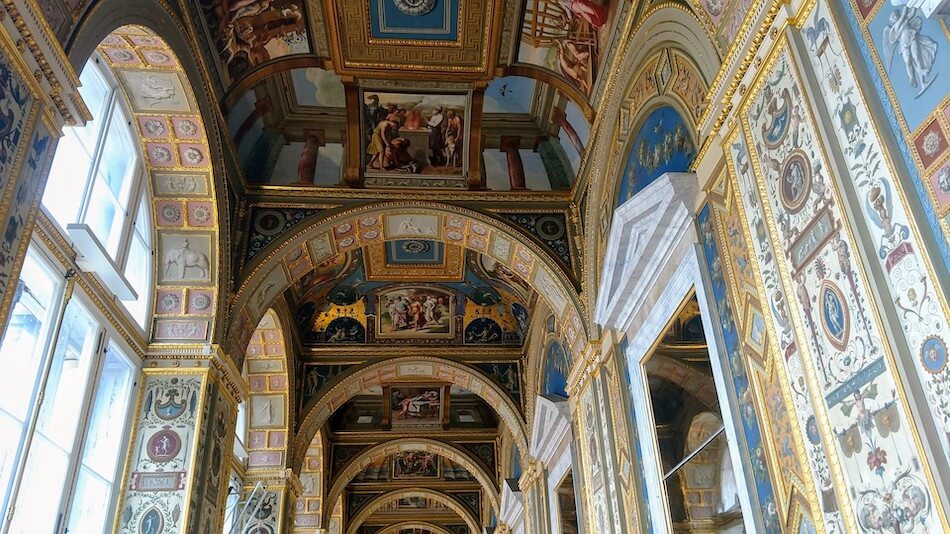
The palaces in Russia are filled with priceless paintings and gold everywhere. This is the ceiling of a room in the Hermitage, the second largest museum in the world. It’s housed in the former winter palace of the Russian tzars.
We arrived early in the morning to St. Petersburg where we would spend our last three days. After touring the scenic small villages, we were back in the big city, considered by many to be the most beautiful city in Russia.
St Petersburg, with more than 5 million residents, is a lot smaller than Moscow and much newer. It was founded in 1702 and served as Russia’s capital for 200 years, until the Russian Revolution.
Formerly known as Leningrad, the citizens here suffered terribly during WWII when the Nazis kept the city under siege for 900 days. There was no food, public transportation, water or much electricity for the 3 million residents, yet the city refused to surrender.
Fortunately a lot of the art was saved from the Nazis by being transported over the frozen Lake Ladoga to the mainland.
Highlights of St. Petersburg
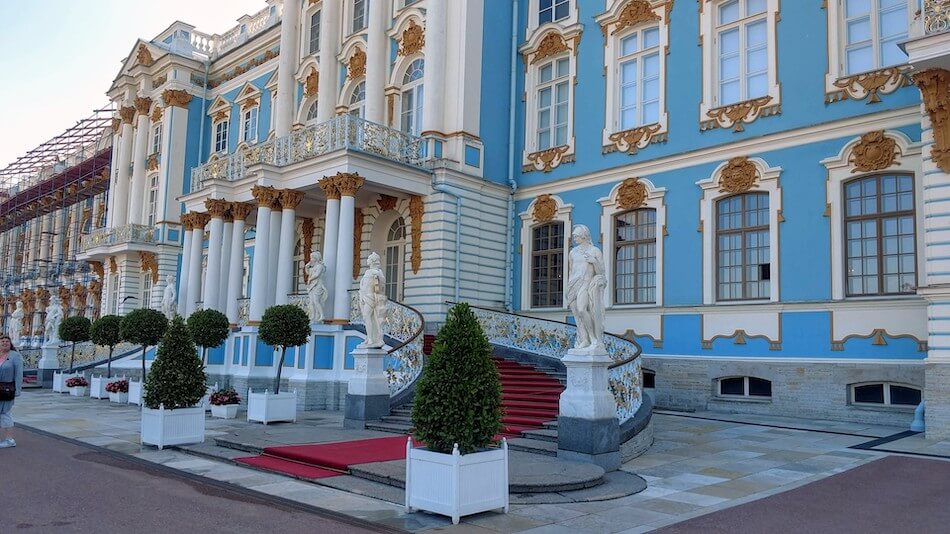
If you think the exterior of Catherine Palace has a lot of gold, wait until you tour inside.
When you go to St. Petersburg you want to visit the three palaces, all gigantic and impossibly ornate. I’ve never seen so much gold in my life. Make time to see Catherine Palace, Hermitage and Peterhof.
I could have spent days strolling through the gardens at Peterhof, where the cascades of fountains surrounded by gold statues rival anything at Versailles, which Peter the Great was trying to emulate when he built this summer palace.
• Performance of the St. Petersburg Ballet. You don’t have to be a dance fan to enjoy a performance of “Swan Lake” in the majestic Mariinsky Theatre.
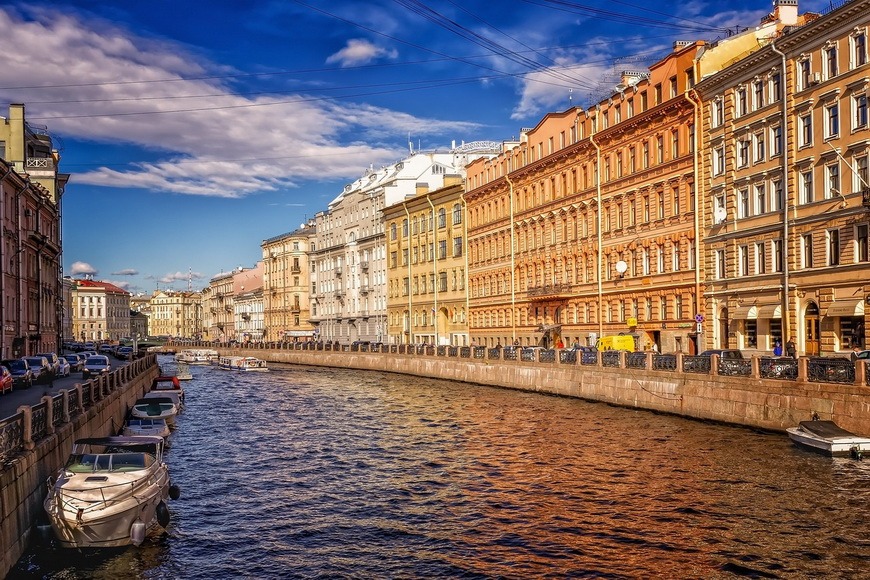
Peter the Great designed St. Petersburg to be seen from the water, following designs of Amsterdam and Venice. The city has more than 340 bridges.
• A boat tour. Peter the Great wanted the city to be seen by water and the main facades of mansions and palaces overlook the Neva River and canals.
• Tour of theChurch of the Savior on Spilled Blood. We battled rain and an unruly crowd at the entrance, but it was worth it to see the magnificent mosaics, covering every square inch of this stunning church.
Tips for St. Petersburg
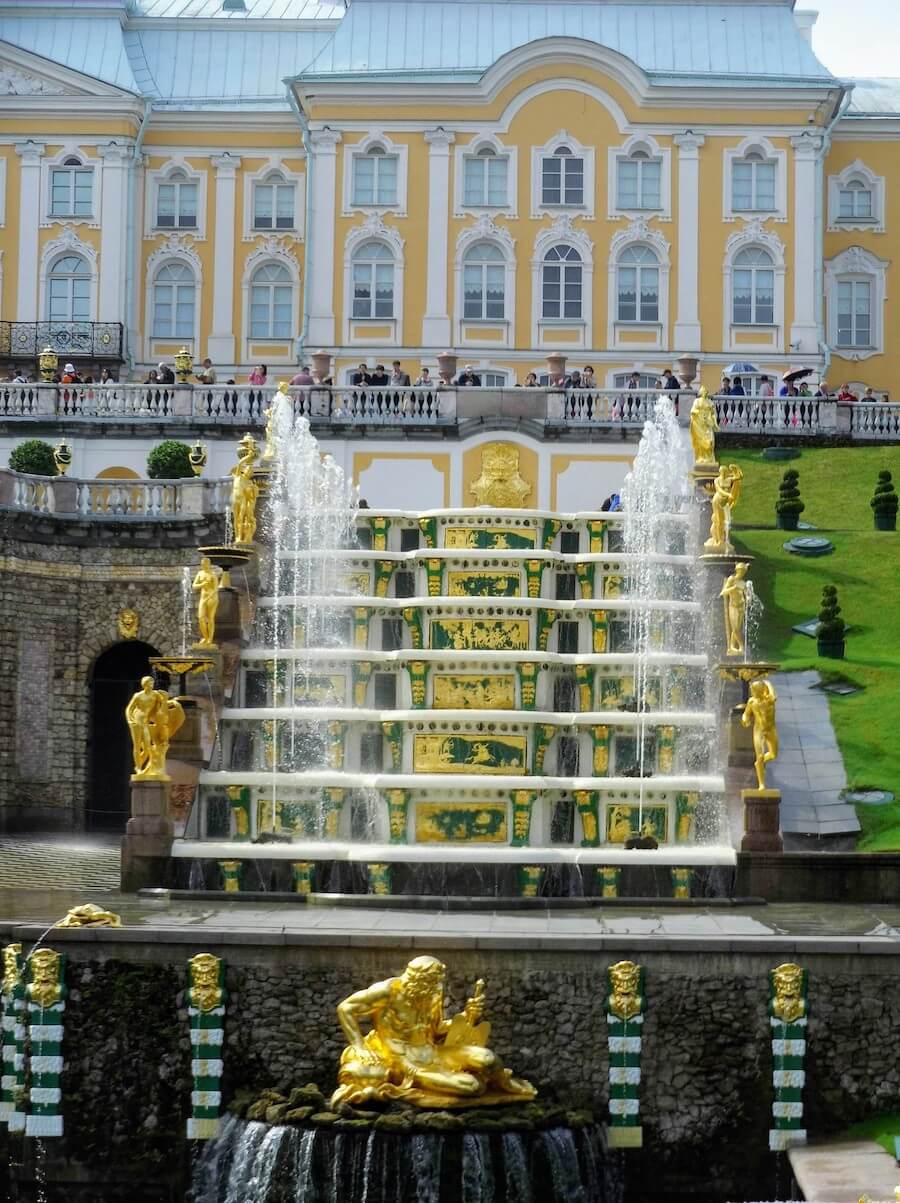
The Grand Cascade is just one section of the fountains at Peterhof. I could have spent a day just in the gardens.
• St. Petersburg only gets 30-45 days of sunshine a year so take your umbrella or jacket. “An umbrella is like our sixth finger,” one guide told us. Viking hands out umbrellas as you leave the ship if the weather looks questionable, but they are the large kind. I prefer to take my small portable one as it’s easier to carry around.
• Like Moscow, the Metro is a good way to get around. Some of the escalators are very, very long so hang on. A woman in our group fell, which prompted the attendant at the bottom to shut the escalator down. Although she had some scrapes on her face, she was okay. We were packed on the escalator so it could have been much more serious.
• Again, watch for pickpockets, especially in tourist areas and on the Metro.
Fun Facts about the Viking Akun
• The ship is 400 feet long and weighs 3200 tons, all loaded.
• We traveled 1,000 nautical miles on our trip. The ship only refuels one time.
• The Viking Akun is one of four Viking River Cruises ships in Russia.
• It was built in 1990 and refurbished in 2014.
If you’ve been to Russia, we’d love to hear about your experience. Please share with us in the comments!
– Jan Schroder, Editor-in-chief of The Travel 100, is an avid river cruiser. She took her first river cruise in 2008 and gets back on the river every chance she gets.
Pin this post:
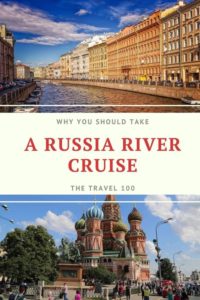

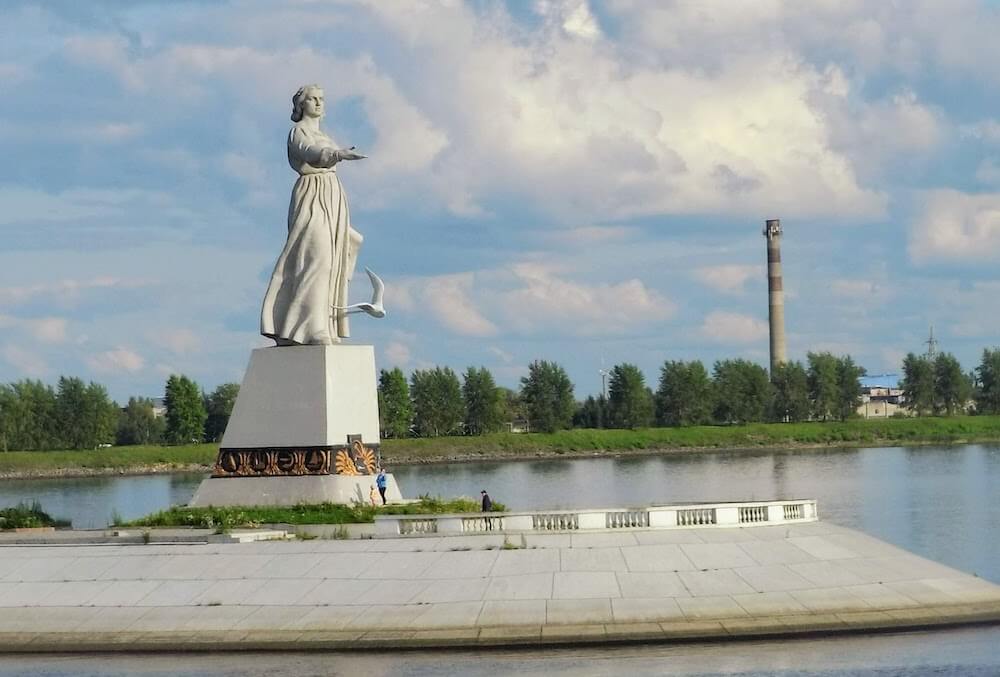
6 comments
[…] Cruises […]
[…] River Cruises […]
I live in Russia, and I enjoyed your perspective on travelling round. Ridiculously chuffed you enjoyed it so much (and I am not even Russian). Great photos too!
[…] River Cruises […]
[…] Cruises […]
[…] Cruises […]